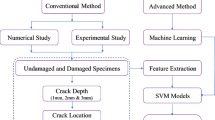Abstract
Tool condition monitoring is increasingly important as a widespread application of automated, computer numerically controlled machining in a variety of modern industries. Although a significant amount of research on tool condition monitoring in machining has been conducted during the past few decades, the research is primarily focused on tool flank wear. Less attention is paid to tool-edge wear, which is a critical issue in high-speed finish machining where the feed rate is in the same magnitude as tool edge dimensions, and thus, the tool cutting edge is subjected to extensive mechanical and thermal deformation. The present study fills this important research gap in tool condition monitoring. This paper presents a method of monitoring tool-edge wear in the high-speed finish machining of an aerospace superalloy Inconel 718 by extracting Hoelder exponents from wavelet transform analysis of cutting vibrations. A total of 60 cutting experiments were conducted, covering a range of cutting speed and feed rate conditions. The experimental results show that cutting vibrations increase as tool-edge wear develops. Wavelet transform analysis can be employed to identify single local maxima of the cutting vibration signals. As tool-edge wear develops, the values of Hoelder exponents vary from 0.55 to 0.90. It is suggested that under the cutting conditions tested in the present study, 0.8 can be used as the threshold value of Hoelder exponents to differentiate severe and normal tool-edge wear.
Similar content being viewed by others
References
Jemielniak K, Urbanski T, Kossakowska J, Bombinski S (2012) Tool condition monitoring based on numerous signal features. Int J Adv Manuf Technol 59:73–81
Byrne G, Dornfeld D, Inasaki I, Ketteler G, Konig W, Teti R (1995) Tool condition monitoring (TCM)—the status of research & industrial application. CIRP Ann 44:541–567
Siddhpura A, Paurobally R (2013) A review of flank wear prediction methods for tool condition monitoring in a turning process. Int J Adv Manuf Technol 65:371–393
Rehorn AG, Jiang J, Orban PE (2005) State-of-the-art methods and results in tool condition monitoring: a review. Int J Adv Manuf Technol 26:693–710
Dudzinski D, Devillez A, Moufki A, Larrouquere D, Zerrouki V, Vigneau J (2004) A review of developments towards dry and high speed machining of Inconel 718 alloy. Int J Mach Tools Manuf 44:439–456
Fahad M, Mativenga PT, Sheikh MA (2012) A comparative study of multilayer and functionally graded coated tools in high-speed machining. Int J Adv Manuf Technol 62:43–57
Pawade RS, Joshi SS (2012) Analysis of acoustic emission signals and surface integrity in the high-speed turning of Inconel 718. J Eng Manuf 226:3–27
Bushlya V, Zhou J, Avdovic P, Stahl JE (2013) Performance and wear mechanisms of whisker-reinforced alumina, coated and uncoated PCBN tools when high-speed turning aged Inconel 718. Int J Adv Manuf Technol 66:2013–2021
Thakur DG, Ramamoorthy B, Vijayaraghavan L (2012) Effect of cutting parameters on the degree of work hardening and tool life during high-speed machining of Inconel 718. Int J Adv Manuf Technol 59:483–489
Thakur DG, Ramamoorthy B, Vijayaraghavan L (2009) Machinability investigation of Inconel 718 in high-speed turning. Int J Adv Manuf Technol 45:421–429
Klocke F, Kratz H (2005) Advanced tool edge geometry for high precision hard turning. CIRP Ann 54:47–50
Almeida FA, Oliveira FJ, Sousa M, Fernandes AJS, Sacramento J, Silva RF (2005) Machining hard metal with CVD diamond direct coated ceramic tools: effect of tool edge geometry. Diam Relat Mater 14:651–656
Wu Q, Fang N (2006) Effect of tool-edge wear in high-speed machining of superalloy Inconel 718. Trans NAMRI/SME 34:397–402
Chen X, Li B (2007) Acoustic emission method for tool condition monitoring based on wavelet analysis. Int J Adv Manuf Technol 33:968–976
Kunpeng Z, San WY, Soon HG (2009) Wavelet analysis of sensor signals for tool condition monitoring: a review and some new results. Int J Mach Tools Manuf 49:537–553
Sun Q, Tang Y, Lu WY, Ji Y (2005) Feature extraction with discrete wavelet transform for drill wear monitoring. J Vib Control 11:1375–1396
Patra K, Pal SK, Bhattacharyya K (2007) Application of wavelet packet analysis in drill wear monitoring. Mach Sci Technol 11:413–432
Li X, Tso SK (2000) Real-time tool condition monitoring using wavelet transforms and fuzzy techniques. IEEE Trans Sys Man Cyber Part C Appl Rev 30:352–357
Wang L, Mehrabi MG, Kannatey-Asibu E Jr (2001) Tool wear monitoring in reconfigurable machining systems through wavelet analysis. Trans NAMRI/SME 29:399–406
Mallat S, Hwang WL (1992) Singularity detection and processing with wavelets. IEEE Trans Inform Theory 38:617–643
Loutridis S, Trochidis A (2004) Classification of gear faults using Hoelder exponents. Mech Syst Signal Process 18:1009–1030
Guo H, Xiong G, Xi F, Zheng J, Ping X (2005) Detection and compensation of cutting tool wear based on Lipschitz exponent. Proc 2005 I.E. Conf Contr Appl, Canada, 1662–1667
Douka E, Loutridis S, Trochidis A (2003) Crack identification in beams using wavelet analysis. Int J Solids Struct 40:3557–3569
Prakash GJ (2008) Damage identification in composite beam using continuous wavelet transform applied to mode shape and strain energy data. Adv Vibr Eng 7:127–141
Peng ZK, Chu FL, Tse PW (2007) Singularity analysis of the vibration signals by means of wavelet modulus maximal method. Mech Syst Signal Process 21:780–794
MATLAB toolbox version 8.2 users’ guide (2013) The MathWorks, Inc., Natick, Massachusetts
MacQueen JB (1967) Some methods for classification and analysis of multivariate observations. Proc 5th Berkeley Symp Math Statis Proba, Berkeley, California, 1:281-297
Kanungo T, Mount DM, Netanyahu NS, Piatko CD, Silverman R, Wu AY (2002) An efficient k-means clustering algorithm: analysis and implementation. IEEE Trans Pattern Anal Mach Intell 24:881–892
Huang JZ, Ng MK, Rong H, Li Z (2005) Automated variable weighting in k-means type clustering. IEEE Trans Pattern Anal Mach Intell 27:657–668
Author information
Authors and Affiliations
Corresponding author
Rights and permissions
About this article
Cite this article
Fang, N., Pai, P.S. & Edwards, N. A method of using Hoelder exponents to monitor tool-edge wear in high-speed finish machining. Int J Adv Manuf Technol 72, 1593–1601 (2014). https://doi.org/10.1007/s00170-014-5764-0
Received:
Accepted:
Published:
Issue Date:
DOI: https://doi.org/10.1007/s00170-014-5764-0




